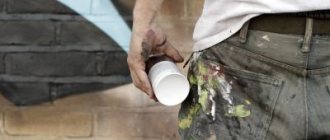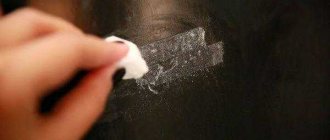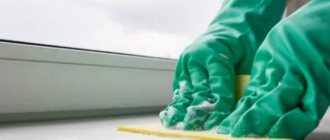In this article we will look at how to wash acrylic paint at home from different surfaces.
No matter how carefully the repair is carried out, stains can get or seep onto your furniture, floors or even things. Now acrylic paint has become very popular, which is much better than the old analogue, but sometimes it leaves stains. Of course, it’s much easier to remove fresh paint, but with old dried stains you need to tinker a little. And we will talk about such minor secrets and tricks in this material.
How and with what to remove acrylic paint?
Acrylic paint is a water-soluble, non-toxic and quick-drying paint that can be used in many areas of human activity.
Important: Acrylic paint is water-based, so it is much easier to clean than its oil-based counterpart.
- Depending on whether the acrylic paint stain is fresh or already dried, there are two options for cleaning the surface. Wet acrylic paint is much easier to remove than the dried version, which makes sense. In many cases, fresh paint can simply be wiped off with a piece of cloth.
- If you see the stain after a few minutes, then it is enough to wash it with plain water, but only in a warm state. It will take a little more effort on your part to scrub it off, or use a hard kitchen sponge.
- Today's stain, which has had time to stand for a little (but no more than 1 hour), needs to be soaked with warm water. To do this, you can simply pour water onto the desired area and leave for 30 minutes. For soft objects, you need to thoroughly moisten a piece of terry cloth and apply it to the contaminated area. After that, just wipe it well.
- Remember - the longer the paint sits, the more difficult it will be to clean . Therefore, a stain that has stood for more than 30 minutes and up to 2 hours will need to be removed with alcohol. Also apply a small amount of alcohol to a piece of cotton wool or a piece of fabric and apply it to the stain. Wait a few seconds and wipe off. But keep in mind that not all surfaces react calmly to contact with alcohol.
It is enough to wipe off fresh paint with a damp cloth.
Nothing helps - what to do?
Removing old layers of paint from plastic that has a complex shaped shape using conventional means can be difficult due to its texture. Using liquid glass and silicone sealant will help solve the problem .
During the natural drying process, these preparations lead to loosening of the paintwork. And dried material can simply be cleaned off.
But if other methods do not help, you will have to use the most radical method - scraping off the dried coating.
For these purposes the following is used:
- sandpaper;
- stationery knife;
- razor blade;
- table knife, etc.
During the cleaning process, the surface is cleaned mechanically. Cured paint is quite hard and will often come off with a layer of plastic when using abrasive or sharp cleaning tools.
Radical methods of cleaning paint, although they cope with the task, but lead to serious damage. Even with great care, irreparable damage can be caused to the surface .
After such cleaning of plastic using aggressive methods, its surface will need to be polished and coated with a new layer of paint.
How to remove and wash off acrylic paint from fabric?
No one is immune from stains on things. And, despite the fact that acrylic paint is water-based, it is still more difficult to remove from fabric surfaces. After all, any fabric consists of fibers, which create the material. They also absorb paint residues well.
- The first thing you need to do is treat the stains before a film layer forms. When acrylic paint is still wet, it can be removed very quickly and easily using the tap washing technique. And for the best result, try to rinse things as quickly as possible in the fast mode of the washing machine.
- To remove dried acrylic paint on clothing, follow these steps: Soak the stained fabric in an alcohol solution. More precisely, place a cotton pad soaked in alcohol on the stain itself. After 10-15 minutes, wipe the stain with the same cotton wool. If necessary, scrape off the top layer with a knife, and then go through it again with alcohol. Finally, simply wash the item thoroughly;
- Instead of an alcohol solution, you can use acetone to remove nail polish or an alcohol-based hand sanitizer. Also be careful with delicate fabrics such as silk. After all, such things cannot be rubbed too hard. Also keep in mind that colored items may change color, so watch out for this when wiping off the paint;
- Ordinary dishwashing detergent can also help, as it will not react so aggressively to the structure and color of things. Just fill the stain completely with it and leave for 3 hours. You can periodically rub the product in thoroughly, and then just wash it;
- Alternatively, hairspray will work great in emergencies. Just spray the area well and wipe off the paint with a cotton ball after 10-20 minutes;
- a folk remedy based on ammonia, salt and vinegar will cope even with a dried stain. To do this, mix the components in equal proportions and apply to the stain. After 5-10 minutes, rub well with the hard side of the sponge;
- in extreme cases, use the above paint removers. They need to be applied using a cotton pad or piece of cloth for 15-20 minutes. The stains will come off easily, but you will need to wash things with a double portion of powder and double rinsing.
Important: Work only with gloves. After all, this way the paint will not imprint on your hands, and aggressive substances can not only dry out the skin, but also cause even minor injuries to the skin.
Regular soapy water can remove stains from fabric.
Professional products
Taking into account the current problem, manufacturers of paints and varnishes have taken care of producing professional products for cleaning paint stains. There are many highly specialized solutions that help get rid of dirt on any surface, taking into account the texture of the material.
Taking into account the current problem, manufacturers of paints and varnishes have taken care of producing professional products for cleaning paint stains.
Wash
A special remover designed to remove stains from any surface, including premium furniture. It is better to work with the drug with gloves and a respirator, as the product has increased toxicity. At a minimum, windows should be opened during processing.
A special remover designed to remove stains from any surface, including premium furniture.
Universal cleaner
This multi-component composition helps to remove not only acrylic paint, but also other paints and varnishes. Small areas are treated with rags soaked in the composition. Leave for 10 minutes (unless otherwise specified by the manufacturer) and remove with a clean cloth. Then, the treated area is thoroughly soaped and washed off with warm water.
This multi-component composition helps to remove not only acrylic paint, but also other paints and varnishes.
When carrying out painting work, it is advisable to immediately remove any stains and dirt that have formed. Cleaning acrylic using chemically active substances is not an easy or safe process, so precautions must be taken.
How to remove acrylic paint from carpet or carpet?
Of course, before painting, you should remove all carpeting to avoid staining it. But there are different situations. It may happen that a new expensive carpet or even carpet will be damaged by acrylic paint. Don't be upset; you need to take immediate action to preserve the beauty of your carpet.
- Fresh paint only needs to be blotted with a paper towel. Do not rub the product into the carpet under any circumstances Otherwise, the paint will only penetrate deeper.
- Then use the same paper towel or cotton ball soaked in glycerin to blot off any remaining paint. This must be done until all the pigment is gone.
- Soak the painted area with rubbing alcohol. Make sure it is completely absorbed and leave on for 5 minutes. This will give time for the paint's weakening effect to begin. Start wiping the area with a paper towel. Do not rub the dye onto clean areas of the carpet when you wipe the stain, but try to keep it in one place, working towards the center. Continue scrubbing until the paint is gone. It may take two or three soaks before all the paint is removed.
Do not rub the stain across the carpet, but try to move towards the center
Recommendations from experts
Professional recommendations will help you cope with this difficult task:
- All work to remove paint from plastic should be carried out using personal protective equipment.
- Excessive physical force, harsh chemicals and abrasive products can damage the plastic.
- If you plan to heat treat water-based paint on plastic, you should take into account that it cannot be carried out at low air temperatures. In this case, the temperature difference can cause deformation of the plastic.
If electrical appliances with plastic casings, sockets, and wall switches require cleaning, they must first be disconnected from the power supply.- After washing electrical appliances, you should wait at least 2 hours before connecting them to the power supply again.
- If a plastic item requires particularly careful handling (for example, a window profile), you should consult a specialist regarding the choice of product.
- Knowing the type of paint that is applied to the plastic will help you quickly select a cleaning product.
In some cases, paint cannot be removed from plastic without damaging the product. At the same time, you must be prepared for the fact that the item may lose its presentable appearance or require serious reconstruction.
How to remove acrylic paint from wood, floors, walls or plastic?
Be sure to take care to protect your hands and respiratory tract. Especially if you work with chemicals or overly aromatic substances. It also helps to ensure proper ventilation. Better yet, point the fan towards the window so that the vapors are blown out the window.
- You need to lift the paint with a pointed tool. Since wood often has a shiny finish and plastic is quite fragile, it is best to use the pick-up method before resorting to chemicals. Use a sharp knife to carefully loosen the edge of the paint stain and try to lift it up.
Important: Do not tilt the knife down, otherwise you will scratch the material. It is also prohibited to place it at right angles to the material.
- You can try to wash dried paint with soapy water and add a little strong detergent. This is one of the best options, which will make it possible to wash the paint without damaging the coating. To do this, you just need to wet the sponge and rub the dirty area well.
- You can also use an alcohol solution (alcohol is replaced with acetone or an alcohol-based disinfectant). Dip the edge of a cotton swab or paper towel into the solution. Then gently wipe the paint stain, trying not to rub it over the entire surface, but to concentrate it in one place.
- If the paint has dried, remove the top layer with a scraper. This could be a spatula, a kitchen knife, a paint scraper, or even the edge of a shovel if there is a large area. If it does not give in, then moisten it a little with plain warm water. Cover with a cloth and leave for some time.
The dried stain needs to be scraped off a little with a spatula.
- Any glass cleaner is perfect for plastic, even a common glass spray. It should be sprayed onto the contaminated area, and after 15-20 minutes, rub well with a sponge.
- A construction hair dryer works great with any type of paint, especially acrylic. It needs to be aimed at the stain and wait for the pigment to heat up. Then you need to remove the top layer with a spatula and wipe with a damp cloth. This method is very suitable even for painted walls or wallpaper.
- Ordinary baking soda helps fight many stains and even paint stains very well. It needs to be sprinkled liberally onto the paint and covered with a damp cloth. Then rub well with a sponge and wipe dry.
- Vinegar can be used as a gentle agent on any surface. To do this, it is diluted in water (if the stain is fresh) or simply poured over the contaminated area. After 10 minutes, wipe everything well with a rag.
- For stains that last 24 hours or more, when folk remedies can no longer cope, then use any solvent that we indicated at the very beginning. You need to moisten a cloth, for example, in kerosene or spirit. Apply for a few minutes (depending on the age of the stain) and rub well with a sponge. Simply wash off any remaining residue with a damp cloth.
Important: If you use chemical solvents, then under no circumstances mix them with folk remedies or detergents. Otherwise, a reaction may occur, as a result of which dangerous and toxic fumes will begin to be released.
Regular baking soda also works well on stains.
Principle of coating removal
Most known methods for removing old paint - mechanical and thermal - are not suitable for plastic surfaces. In particular, when heated, some plastics can undergo thermal destruction: they warp and emit an unpleasant odor. The mechanical method will cause irreversible damage to the plate of the original material (unless, of course, this is not the goal). There remains a chemical method for removing old paint.
The choice of active substance to wash off the old coating depends on the physical and chemical characteristics of the object - be it windows, shelves or small decorative forms. Therefore, first of all, it is necessary to find out what kind of plastic is supposed to be processed. If there are no extra finishing plates left, you will have to experiment on inconspicuous parts of the product.
How to remove acrylic paint from furniture?
If it happens that your chair, sofa or favorite armchair has been stained with acrylic paint, then you need to wipe off the fresh stain as soon as possible. If the paint has already dried, then you will need to make more efforts to ensure that your furniture does not lose its appearance.
- For fabric surfaces you need to use natural and gentle substances. After all, for example, alcohol or solvent can cause a color change. Or even completely ruin the material itself. Therefore, the ideal solution is simply soapy water.
- You can also use soda slurry, which is diluted simply with water. Apply this mixture to the stain and rub well with a sponge after 15 minutes of contact.
- You can mix a drop of detergent, a spoonful of baking soda and a glass of water. Finally, add a spoonful of vinegar, shake well and spray onto the stain. Such contact of substances will help “pull out” the pigment even from the deepest fibers.
- If there are wooden inserts, then rubbing them is highly not recommended. After all, scratches may appear. In this case, you need to work with each section with different options or go through them with progressive movements.
- Simply, wooden furniture can be wiped with any of the above products or solvents. Or carefully use a spatula, a stiff sponge and a hair dryer.
- Alternatively, you can use an iron instead of a hairdryer. You just need to iron the surface through the foil. The paint will print, and the residue can simply be wiped off with a damp sponge.











